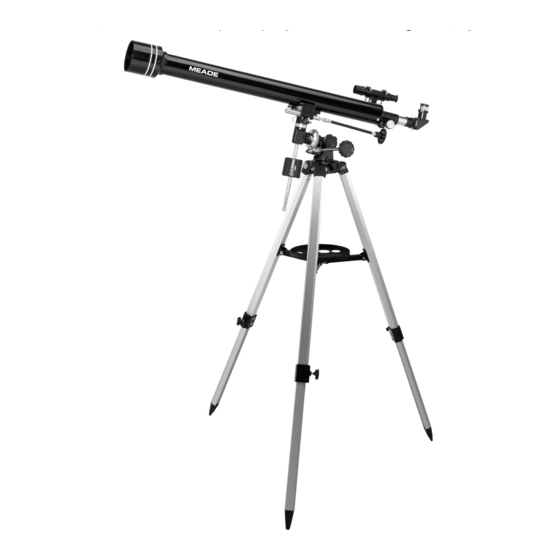Summary of Contents for Meade 60EQ-D
- Page 1 Instruction Manual Meade 60EQ-D: 2.4" (60mm) Equatorial Refracting Telescope Meade Instruments Corporation 6001 OAK CANYON, IRVINE, CALIFORNIA 92618-5200 U.S.A. (949) 451-1450 FAX: (949) 451-1460 www.meade.com © 2003 08/03...
- Page 2 ONE YEAR from the date of original purchase in the U.S.A. Meade will repair or replace a product, or part thereof, found by Meade to be defective, provided the defective part is returned to Meade, freight-prepaid, with proof of purchase.
-
Page 3: Table Of Contents
Applications of the Telescope ........10... - Page 4 2& Fig. 1: Meade 60EQ-D 2.4" Equatorial Refracting Telescope Features in Fig. 1: 1. Adjustable sliding inner leg extension 2. Sliding leg extension lock 3. Accessory tray 4. Leg brace 5. Leg brace support 6. Tripod legs 7. Tripod-to-mount attachment point 8.
-
Page 5: Standard Equipment
Fig. 4: Attaching the viewfinder. Features in Fig. 4: 16. Viewfinder collimation screws 37. Viewfinder bracket mounting thumbscrews Fig. 7: Attaching tripod legs to telescope mount. Features in Fig. 7: 6. Tripod leg 41. Telescope mount 42. Wingnut and bolt... -
Page 6: Introduction
8. Tilt the polar axis (40, Fig. 2) of the telescope to roughly a 45° angle with the horizon. This tilt is accomplished by first loosening the latitude adjustment lock (33, Fig. 1), adjusting the mount and firmly re-tightening the latitude control lock. -
Page 7: Aligning The Viewfinder
BALANCING THE TELESCOPE In order for the telescope to move smoothly on its mechanical axes, it must first be balanced as follows: Note: If the counterweight is positioned as recommended on the previous page—the telescope is already approximately balanced. -
Page 8: Lining Up With The Celestial Pole
Declination, the task of finding objects (in particular, faint objects) in the telescope is vastly simplified. The setting circles, R.A (34, Fig. 2) and Dec. (25, Fig. 2) of your telescope may be dialed, in effect, to read the object coordinates and the object found without resorting to visual location techniques. However, these setting circles only perform correctly if the telescope is properly aligned with the North Celestial Pole. -
Page 9: Using The Telescope
(i.e. a different latitude). The only polar alignment procedure that you need to perform each time you use the telescope is to point the polar axis due North, as described in step (1) above. -
Page 10: Applications Of The Telescope
The focal length of the Meade 60EQ-D is 900mm. To compute power, divide the focal length of the eyepiece into the focal length of the objective lens. The result is the magnifying power of the telescope. For example, when the 25mm eyepiece is used with the Meade 60EQ-D: The Barlow lens serves to increase the power of each eyepiece. -
Page 11: Maintenance
The most often useful higher magnification with any 60mm diameter telescope is in the range of 80 to 120 power. The general rule to follow with any telescope, regarding power: Only use as much magnification as supports a steady, well-defined image. This often varies with the stability of the air being viewed through and is one reason why having various eyepieces is highly desirable.














